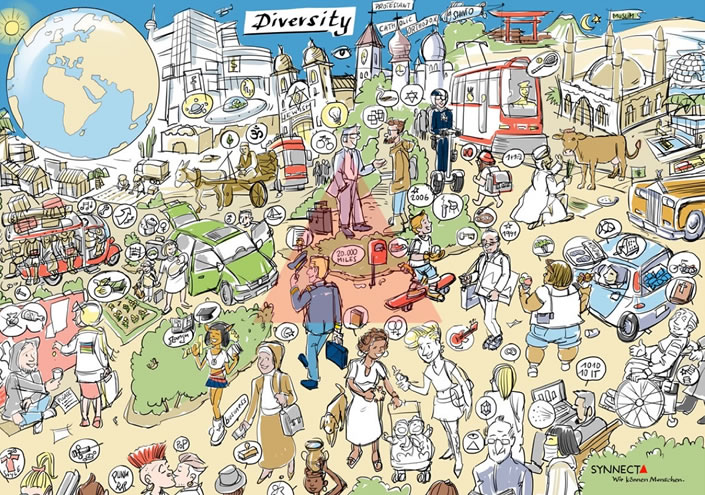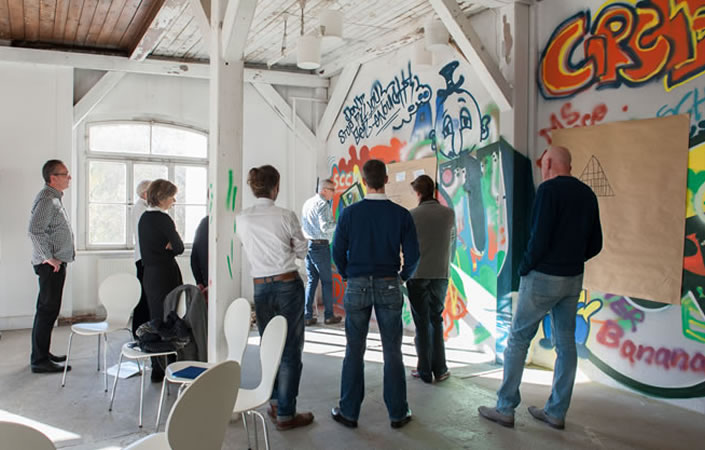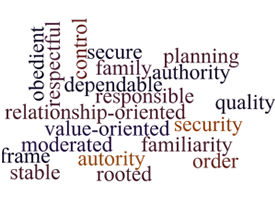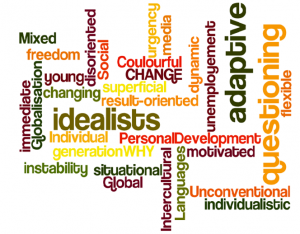3. March 2020

Use the variety of perspectives in your company to become more creative
How do we become more innovative?
This question is becoming increasingly urgent for many companies to keep up with the competition. Without innovation, time is running out for many companies.
The countdown is ticking:
- Is your company already in the starting blocks to »launch« the next innovation?
- Where does the innovative power in your company come from?
The potential for innovation have many companies. It is important to exploit this potential and thus strengthen the company from the inside out. This can mean giving space to lateral thinkers and also taking uncomfortable paths at times. With a disruptive, innovative force, even a monoculture can open up – and thus gain new, innovative perspectives.
Monocultures have a comparatively low complexity – and produce reliable, but also rather boring and predictable answers. Diversity, on the other hand, increases complexity; it counteracts simplifying response patterns – thus providing »blurred« answers with higher ambiguity. This is more demanding – but it also opens up the prospect of better, more groundbreaking solutions.
Learning to ride the tiger – jumping towards more innovation
A plausible thesis is:
»A company can only serve the market that it can internally map.«
This is how Dr. Rüdiger Müngersdorff from the management consultancy SYNNECTA, our cooperation partner in organizational development, puts it.
 Illustration: SYNNECTA Diversity Insight Map®
Illustration: SYNNECTA Diversity Insight Map®
SYNNECTA’s Diversity Insight Map® is a tool with which people are encouraged to engage in dialogue. The topics around diversity become visible and can be discussed.
A healthy diversity in the company does not only ensure that the products and services fit the market. It also promotes a forward momentum within the company that triggers new dialogues and generates ideas. The aim is to constantly rethink and reflect on one’s own certainties and thus be able to act tomorrow.
»Tensions in the company should be good?!« you might ask yourself now. – It is useful to differentiate two types of tension:
- A negative tension describes, for example, a climate of fear, of isolation or personal intrigue. Here, people feel insecure, shut themselves off and tend to only »work to rule«.
- Positive tension, on the other hand, refers to the creative energy generated by allowing different perspectives. Creative processes are not self-propelling, but usually hard work. The joint struggle for the best solution, overcoming mental barriers – the proverbial »out-of-the-box thinking« – all this requires a certain productive tension.
Even agile work or methods such as »design thinking« actively use non-conformist or external perspectives to increase the diversity and thus the creative tension within the system. Those who want to make their company the driving force behind innovations – even disruptive innovations – must not only endure this creative tension, but also actively use it for design purposes. In the free interpretation of a Chinese proverb: You must learn to »ride the tiger«.
Why does diversity become an essential concept for companies?
Promoting diversity in the company is one of the approaches to boosting creative, positive tension. Diversity is a collective term for a multitude of differences. At least the following so-called »diversity dimensions« can be differentiated:
- Cultural differences, often in the sense of ethnic-cultural or religious differences, are regularly understood as relevant differentiation.
- In society, disability is all too often a stigma that leads to a disregard for the potential of people with disabilities – a naive waste of resources from a company’s point of view.
- Gender: The »small« difference between man and woman is clear to everyone. Since 2017, the German Supreme Court (Bundesverfassungsgericht) has distinguished people who do not assign themselves to either of these two categories (official term »diverse«). Reality has always looked more colorful. »Girls play with dolls – boys with cars.« True, if you keep in mind (and preferably say it, too) that many girls also play with cars and many boys with dolls and figures.
- Age: We were all young once – and the hope unites us to become old. But that doesn’t save companies from inter-generational conflicts and misunderstandings in the workforce. Demographic change is fueling this tension: especially when young employees lead older employees – or when the »young« do not feel understood by the »old« – the difference in age suddenly becomes relevant for cooperation within the company.
- Sexual identity or orientation: »It’s a private matter after all« is the cry of naïve conformists. As those belonging to the majority frequently do not understand the concerns of the minority. But it’s not that difficult: Those who feel they have to hide »the private matter« in everyday life in the office or factory hall will be more secretive and focus their energy on secrecy – instead of on the next innovation in the company.
A decisive advantage for entrepreneurs: studies show that diversity in a company benefits them economically. Companies with high diversity are more innovative, have a stronger employer branding and a better working atmosphere. In short: diversity creates dividends.
To innovate you need to understand perspectives and recognize needs
If you want to strengthen the innovative power in your company, you should be able to change your perspective when searching for innovative opportunities. All too often, innovation processes begin with the question: »How can we improve our product?« – Sounds reasonable, but puts the cart before the horse. The initial question should rather be:
- What solution does the customer desire from our offer?
- What problem does our offer solve for the customer?
- From his/her perspective, what becomes easier, faster, better, cheaper …?
This »101 of product development« (but also of sales, marketing, service) is unfortunately often forgotten and many companies first look at their offers from the »technical« side. The result is technical improvements – but they often do not provide any noticeable benefit to the customer. The key question is: »What additional benefits does the innovation create to the customer – from his/her point of view?« Every innovation must pass through the bottleneck of the customer’s perspective – otherwise it is not an innovation but only a variation. In short: Start with the customer’s perspective – not that of your offer!
An example from the DIY (do-it-yourself) sector: Instead of further improving the existing drill from your range, for example by increasing the speed or lowering the price, you might come up with the disruptive idea of developing a strong adhesive strip – after you have understood that most people in the household only need comparatively tiny holes to hang up light objects (towel hooks, pictures, wall mirrors).
But this change of perspective requires at least two skills: On the one hand, you need to be able to cognitively engage with the customer, his context and his challenges. On the other hand – and this is often the difficult part – you have to be able to feel his emotional situation (his »pain«). You need to be able to sense the different needs of the client. So you need a high degree of social empathy.
And this is where diversity and diversity management come in: The more complex my internal cosmos, which I have to manage in my company, the easier it is for me to understand the complex worlds of my customers. Consider: A range of services for women – designed only by men; a machine for the Indian market designed only by German engineers; a range for young people designed only by »old hands«? – Yes, anything is possible, but the chances are high that the target group’s needs will not be met. More promising is the approach of integrating diversity and complexity into one’s own processes at an early stage.
Why diversity promotes agility in your company
Diversity expert Hanna Göhler points out that for agile organizations, the competent handling of diversity is an important prerequisite for being able to use the potential of agile methods. Agility is a cultural issue. She puts forward the thesis:
- »Only those who are aware of diversity in the group, appreciate it and make it usable, can be and work truly agile. This makes diversity a topic of system, culture, leadership and individuality.«
More on this in her readable article »Why agility and diversity belong together«. There she also explains the concept of »diversity learning« as part of a learning culture towards more agility. Hanna Göhler writes:
»Ambiguity tolerance« (i.e. the ability to tolerate ambiguities and differences or even better to accept them) is regarded as a characteristic of diversity awareness. It is also indispensable for the agile mindset. If this ability is lacking, people react to ambiguous and often uncontrollable situations in an agile setting with »linear thinking«. They fall into rigid, old, traditional patterns, the opposite of »being agile« and constructive diversity learning.
How do you set a base from which innovations can grow?
For managers it is important to create a common base and a stable framework in which the creative tension can stimulate ideas and does not become destructive. This also addresses questions of corporate culture, which should be characterized by trust, open feedback and a pronounced sense of community. This is the only way to build bridges and avoid typical silo thinking, e.g. between departments or teams.
Support the diversity and the overarching exchange within the company. Invite open dialogues and disruptive ideas. In workshops and at larger events, focus on the potential that lies in cross-hierarchical, cross-functional or cross-regional exchange. Allow a little more »colorfulness« in the company and make sure that your company is a place where positive tension can unfold its creative power.
For futher reading (in German):
Daniel Goetz
This article was first published by the author in agateno’s blog at www.agateno.com.
Photo: Matthew Schwartz by unsplash.com
4. July 2019

Basic Thesis
Each person acts from an individual mindset [as part of the personality]. Human communities act from a collective mindset [as part of culture].
What is a Mindset?
A mindset comprises personal or collective dominant attitudes and thought patterns, as well as basic attitudes, convictions and beliefs.
Why is Mindset important?
A mindset is highly dependent on perceptions, feelings, thinking, decisions and behavior, and has an effect on the shaping of relationships, group dynamics, group identity and culture.
How is a Mindset created?
An individual mindset develops in the course of life and continues to develop. It is shaped by education, social context [values, norms and rules, as well as the collective mindset] and is influenced by experience [learning]. A collective mindset is created by the subconscious passing on of specific thought patterns, attitudes and beliefs [e.g. through traditions, community rituals and symbolic systems].
When/Why should one deal with Mindset?
A mindset shapes the available room for thought, decisions and behaviour, thus opening up possibilities and limiting possibilities.
Is Mindset changeable?
A mindset can be changed. Reflection upon, awareness of, and active engagement with mindset open up spaces and possibilities for movement and development. By moving an individual mindset, the collective mindset can be influenced and vice versa.
At Werkhaus19 we have dealt intensively with the topic MINDSET and will continue to work on it, think, write about it in the future.
13. July 2016

I described the fundamental aspects of agile talent management in my last blog post on the topic of talent management: a development-guided notion of talent, talent enabling, self-organization and a supportive talent culture. Building on that, I will now propose further thoughts on actually implementing these in a company.
Talent management with flexible formats
In agile environments, talent management – or rather talent enabling – needs to be dynamic instead of process-driven. We therefore have to question specified annual cycles of talent management. There is little point to conducting employee conversations at pre-set points in time when work structures undergo dynamic change and project cycles take the form of thirty day sprints. The format of the employee conversation is still an important tool in principle. It does not do, however, to use it as a mere step within a process. In other words, feedback is provided, individual development desires and training requirements are talked about and employees are evaluated whenever there is an occasion to do so. The timing is variable, as are the persons who are invited into the setting. Team colleagues may be included, where necessary. Employees and managers have to be enabled to apply these formats for talent flexibly and apply them in their own manner as required.
Talent management software must not be the structural guide for talent development. This is even more true now than it was in traditional forms of organizations. Interaction and learning by experience are pivotal. A a result, talent management and its supporting systems gain a new flexibility. Adaptable and accessible formats for talent are more important than one continuous talent process.
New roles in intrinsic career management
My previous contribution described development-guided behavior and self-organization in talent management; these create a demand for new skills in an organization. Employees now shoulder more responsibility for themselves and their career development. In traditional companies, career planning is often still based on the mechanism of the system: pre-ordained career paths, promotion cycles, appointments as high potential, which will surely deliver the employees – given good work – to the correct (and crucial) position in the organization. Linear formats of this kind no longer work in agile environments. The employees need to establish their own profile of competence by themselves, as well as being able to name their personal motivation and values truthfully and in detail in order to deduce from these their career goals and action plans. It takes a new way of thinking and acting to be able to perform this kind of self-direction. The employees can be supported in their self-organization by way of staff offers with regard to career planning. Such offers include, e.g., position reckoning, peer coaching, job shadowing and mentoring.
Managers will also have to rethink and assume their role as a talent coach. As a professional coach does, they do not decide career questions, but are required to accompany the employee with regular feedback and negotiation that takes into account the available capabilities. They help to identify fields for development and to attain learning goals, they make educational offers, e.g, for new projects. Managers may need support in order to implement this role. This can come in the form of training. However, what is required is not only the attainment of concrete skills but also a new understanding of the management role, as is generally true for agile organizations. As in other fields, the managers will assume a moderating and supporting function in talent management.
Agile talent management requires new formats and interventions. New attitudes and roles need to be assumed and accepted so that flexibility and personal responsibility can be implemented successfully.
Anke Wolf
30. June 2016

The form of talent management I witness in many organizations is maintained via talent identification and process management. Yet, these inflexible models are rarely able to permit the flexibility that is required in complex, agile environments. If talent management means to tap and foster employee potential in new forms of organization as well, it must leave behind the old, linear ways of thinking and acting and, like the business itself, become non-linear, agile and flexible.
Development-guided notion of talent
A development-guided notion of talent is a helpful addition in this context. In contrast to a static notion of talent, the development-guided understanding does not focus primarily on such categories as talent and high potential. It considers all employees and kinds of talent, essentially the »power of the many« and not the »vital few«. It is a way of maintaining performance and innovation in an uncertain and dynamic situation: by mobilizing the entire staff, distributing the risk and having an experimental attitude.
Differences in performance and potential should not be denied, but considered subject to alteration across time as well as situations. Stanford professor Dr. Carol Dweck demonstrated a startling effect in studies and examples: The mere conviction that abilities can fundamentally always be improved by way of effort and learning by experience has a surprisingly positive influence on individual learning achievements and eventually also the success of a business. Rigid categories of talent and intelligence are more likely to result in status thinking and eventually in standstill (Carol Dweck: Mindset. Changing the way you think to fulfill your potential).
Being guided by development also means that talent management in agile environments is less predictable and more iterative. The aspect of »management«, meaning direction, loses its primacy and can be replaced by »enabling«. Talent enabling is a more appropriate term to describe the way companies enable their employees to free their potential and make this potential available for the company.
Self-organization in talent management
Development-guided talent enabling will profit from concepts such as »learning agility« (a.o. Center for Creative Leadership). The skills entailed in learning agility include the ability to question the status quo, to learn from experience, as well as reflection, feedback and the willingness to take risks. These aspects are surprisingly reminiscent of a SCRUM Sprint. There is little room for rigid formats like career paths. This is so not only because career paths appear to be of little benefit in a fast-changing environment with fluid roles, but even more so because agile organizations live off their employees’ self-guidance and intrinsic motivation. Self-organization means giving the employees responsibility for their development while still remaining at the helm as a company and especially as a manager. Self-organization in the sense of learning agility means that employees identify the need to learn and expand their skill set by learning from experience, reflection and feedback; in that context, it falls to the manager as the person accompanying this process to provide stimuli, give feedback and actively offer learning opportunities. The company as a whole also needs to foster a comprehensive talent culture that goes beyond role descriptions and organization charts to value and sponsor employee learning, trial and error (yes, also the latter), and reflection.
Talent management in agile organizations therefore requires new terminology, new attitudes and a culture that adopts and integrates the company’s own non-linear development.
Anke Wolf
Coinciding with this article we are pleased to introduce one of our associated partners: Anke Wolf from Anke Wolf Coaching & Consulting is a recognized expert in talent management and leadership.
1. November 2012
Dealing with generations in the organisational context
X, Y, Z, I … seeing generational gaps and the differences they bring by as a simple trend would be a clear understatement of the phenomenon. Who, among you, hasn’t heard at least once of the stereotypes and theories surrounding the different generations, and who hasn’t tried to find which one you belong to? Between the »Baby Boomers«, the generations X,Y, Z and I, everyone is categorized into well-defined groups and criteria: what kind of people these generations represent, when they were born and why they think in their own, particular way.
 I have gone through several articles on how to deal with different generations in organizations, and can’t help but try to identify myself with one of them, find out which one I »belong to«. I was probably born around the same time as most of you, who are reading this note right now. Our parents, who were in majority born right after World War 2, knew a world were nothing was easy, and money was everything. Manufacturing jobs, production lines were blossoming while the world was trying to make up for the dire and hard war times, giving birth to the »materialist regime«. Typically, at the age of 18-25, our parents had become typical hard workers, moving to the main cities to work, and sending back home the little money they had earned to support their families – which often included grandparents and several younger siblings. They worked overtime and were loyal to their company, most of them their entire life long. They saved much, spent little, aimed to own a small piece of land they could build a house on. If I am correct, this pretty much describes the lives of my parents’ generation – the so-called »baby boomers«.
I have gone through several articles on how to deal with different generations in organizations, and can’t help but try to identify myself with one of them, find out which one I »belong to«. I was probably born around the same time as most of you, who are reading this note right now. Our parents, who were in majority born right after World War 2, knew a world were nothing was easy, and money was everything. Manufacturing jobs, production lines were blossoming while the world was trying to make up for the dire and hard war times, giving birth to the »materialist regime«. Typically, at the age of 18-25, our parents had become typical hard workers, moving to the main cities to work, and sending back home the little money they had earned to support their families – which often included grandparents and several younger siblings. They worked overtime and were loyal to their company, most of them their entire life long. They saved much, spent little, aimed to own a small piece of land they could build a house on. If I am correct, this pretty much describes the lives of my parents’ generation – the so-called »baby boomers«.
Their children – »generation X« and my generation – are currently raising today’s Y and Z children. Those were born after the video tape, remember home phone numbers in a blur, and communicate in a completely different way than their parents: Modern dialectics and linguistics changed into TEXT-nology – even around the dinner table.
At home, the baby boomers (my parents), the Xs (myself) and the Ys and Zs (my children) seem to get along just fine. Things were different when I was a child: I used to play with empty boxes, cans and containers; toys were exceptional and given only for special occasions. Today, my ever-saving, extremely careful parents are retired, and seem to make the most of their retirement fund and savings. They are dazzled at the idea of being able to get what they can afford, and do not hesitate to spoil their grandchildren with what they probably wanted, but couldn’t do for their own children. As a Welsh proverb says, »Perfect love sometimes does not come until the first grandchild«.
 When it comes to the corporate and professional sphere however, things tend to be more complicated. Because all three generations were raised in such different ways, with different technologies and social backgrounds, misunderstandings and conflicts can occur. This topic is becoming increasingly important to companies, as generation Y is currently entering the labour market: »How can organizations deal with generational differences, especially when it comes to handling change and the company’s subsistence?«
When it comes to the corporate and professional sphere however, things tend to be more complicated. Because all three generations were raised in such different ways, with different technologies and social backgrounds, misunderstandings and conflicts can occur. This topic is becoming increasingly important to companies, as generation Y is currently entering the labour market: »How can organizations deal with generational differences, especially when it comes to handling change and the company’s subsistence?«
Dealing with people has never been easy. Most of the time, the Human resources department is given the delicate task of monitoring »corporate harmony« and dealing with such issues. In my own perspective as an HR-Manager, I do not believe that this task should incur to this department in particular. It’s not that I don’t want to have to deal with it, on the contrary; rather, it’s because I believe that every manager is an HR-Manager. Teams somehow function in a similar way than families. The HR department can’t do anything more than organize team-building activities, which is enjoyable and necessary, but also only acts on the surface of the problem. The root of it is, in my opinion, actually »COMMUNICATION« between leaders and team members, who of course differ in terms of generations. Many organizations lose a lot of time trying to fix the problem of »organizational relationships« rather than simply accept the differences between people and live with them rather than against them.
Let’s consider, as an illustration, the following scenario:
Upper Manager, Baby Boomer, my subordinate: »I don’t care HOW you do it, we must cut ALL costs down. These are all useless expenses, and what are ›Employee Relationship Activities‹ for anyway? They should be thankful to have a job in these unstable economic times. Cut heads if you have to.«
Me, Head of Department, Generation X, to my Junior Manager: »Well Junior, we have to rethink our costs, some of them must be cut down. Could you please check them, as well as the headcount plan, and delete all the activities you believe are not absolutely necessary from the budget. I know it is hard to accept, but we might need to let the underperformers go or re-arrange the organizational chart somehow.«
The Junior Manager (Gen Y): »This is absurd – he can’t cut off associates just like that, it’s almost against Human Rights! This is unfair; the company should rethink its position on letting people go for the sake of its margin!«
In this scenario, who do you think is right or wrong?
My answer is actually: No one is either right or wrong. If we look at the problem in an objective way, the solution involves finding the »bridges« between opinions – and generations. The one who can create a bridge to close the generational gaps can shorten the distance between trans-generational teams in just 3 simple steps:
- Understand the differences; accept that people come from different places. People who have a belief or attitude towards life are similar. Tell yourself »This is not a bad person.«
- Admire the good points, rather than obsess over the negative aspects. Try to look for the strength of each person within your team, rather than complain about their weaknesses.
- Adjust the way each group communicates with each other, so they can easily access each other and bring out the best possible result from the discussion.
When you think about it, who do you believe is best suited to close this gap? Those born at the time of the first Star Wars episode, when mankind was sending spacecraft out to the skies? Who knew the era of Walkmans, video games, and have gone through each milestone of communication technologies – from simple pagers to iPhones, and who were the pioneers of internet usage in the early 80s. Aren’t the best bridges the ones who can link the past and the present, the generation X? I would like to believe so.
Three generations are currently at the core of organizational development, and companies have to be able to balance and reduce the gap between their different beliefs and attitudes. Now is the perfect time for corporations to take a look inward and reflect on the bridges they have, and those they still have to build, as change is an ever-continuing phenomenon. So, are you the bridge?
Anoma Paksutti

 Illustration: SYNNECTA Diversity Insight Map®
Illustration: SYNNECTA Diversity Insight Map®



 I have gone through several articles on how to deal with different generations in organizations, and can’t help but try to identify myself with one of them, find out which one I »belong to«. I was probably born around the same time as most of you, who are reading this note right now. Our parents, who were in majority born right after World War 2, knew a world were nothing was easy, and money was everything. Manufacturing jobs, production lines were blossoming while the world was trying to make up for the dire and hard war times, giving birth to the »materialist regime«. Typically, at the age of 18-25, our parents had become typical hard workers, moving to the main cities to work, and sending back home the little money they had earned to support their families – which often included grandparents and several younger siblings. They worked overtime and were loyal to their company, most of them their entire life long. They saved much, spent little, aimed to own a small piece of land they could build a house on. If I am correct, this pretty much describes the lives of my parents’ generation – the so-called »baby boomers«.
I have gone through several articles on how to deal with different generations in organizations, and can’t help but try to identify myself with one of them, find out which one I »belong to«. I was probably born around the same time as most of you, who are reading this note right now. Our parents, who were in majority born right after World War 2, knew a world were nothing was easy, and money was everything. Manufacturing jobs, production lines were blossoming while the world was trying to make up for the dire and hard war times, giving birth to the »materialist regime«. Typically, at the age of 18-25, our parents had become typical hard workers, moving to the main cities to work, and sending back home the little money they had earned to support their families – which often included grandparents and several younger siblings. They worked overtime and were loyal to their company, most of them their entire life long. They saved much, spent little, aimed to own a small piece of land they could build a house on. If I am correct, this pretty much describes the lives of my parents’ generation – the so-called »baby boomers«. When it comes to the corporate and professional sphere however, things tend to be more complicated. Because all three generations were raised in such different ways, with different technologies and social backgrounds, misunderstandings and conflicts can occur. This topic is becoming increasingly important to companies, as generation Y is currently entering the labour market: »How can organizations deal with generational differences, especially when it comes to handling change and the company’s subsistence?«
When it comes to the corporate and professional sphere however, things tend to be more complicated. Because all three generations were raised in such different ways, with different technologies and social backgrounds, misunderstandings and conflicts can occur. This topic is becoming increasingly important to companies, as generation Y is currently entering the labour market: »How can organizations deal with generational differences, especially when it comes to handling change and the company’s subsistence?«